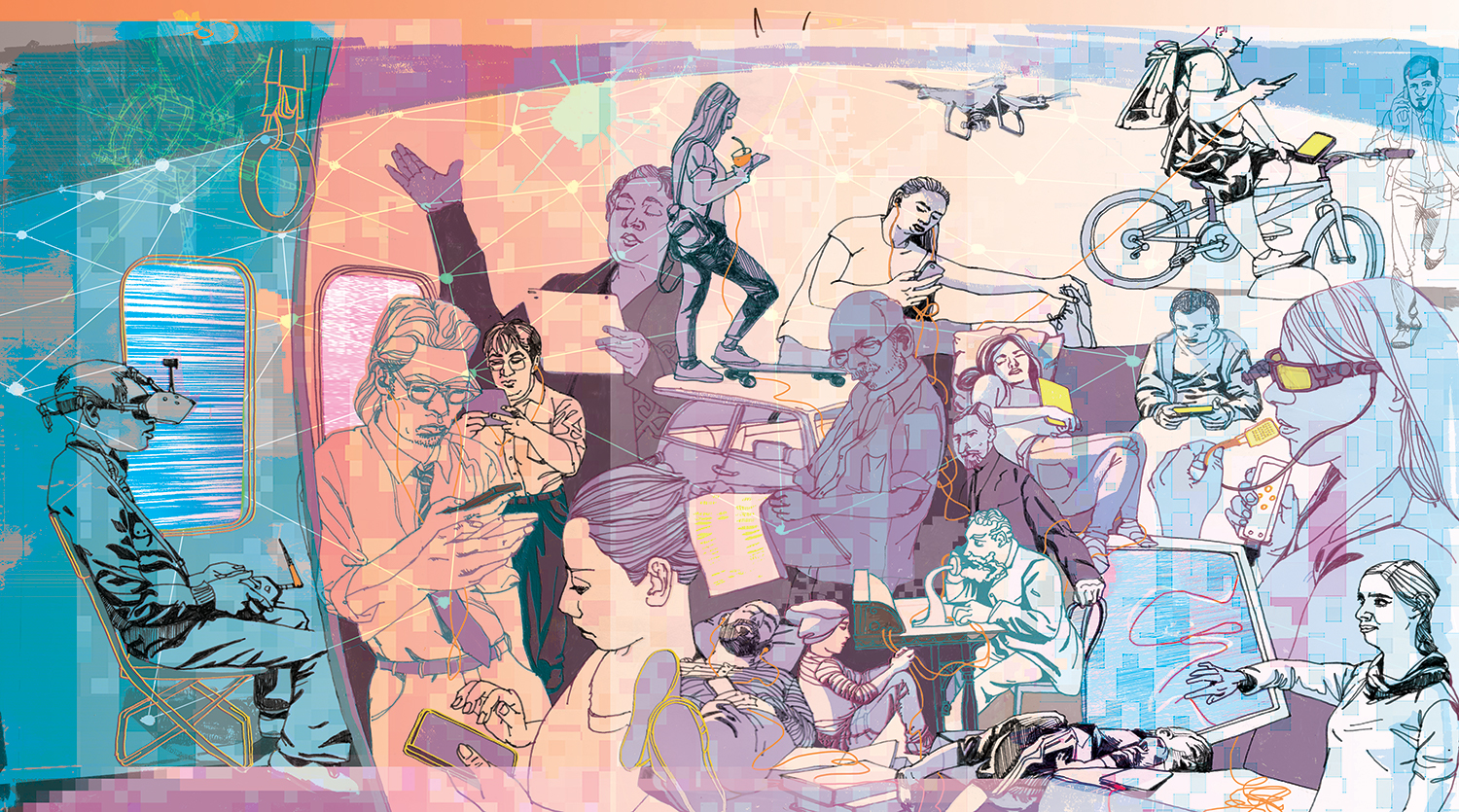
If you happen to be in your 40s as we are, you might remember your first Walkman. The very word evokes the memory of riding a school bus to a skating rink, cranking up Bon Jovi through the foam-padded headset wired to a box that was barely small enough to hold in one hand, fueled by the all-too-short life of two AA batteries. This was when our listening options toggled between either radio or cassette tapes, and “rewind” literally involved tape spinning in the opposite direction around a hub.
That world no longer exists.
Whether or not you miss skating rinks or the humming sound of cassette tapes rewinding is beside the point. For several decades, with ever-increasing momentum, families have welcomed one game-changing new system, appliance, or device after another into our homes. But what’s causing parents some of our biggest headaches is the technology that lands directly in kids’ hands.
Today those devices are almost universally digital, mobile, and ever-connected to the outside world—school buses and skating rinks optional.
Consider that among US households, 82 percent of today’s teens, 72 percent of preteens, and even 70 percent of their parents report sleeping with their smartphones next to them at night.1 This development alone signals the plethora of new questions about digital media that individuals and families face. As author and Fuller trustee Andy Crouch observes, “The pace of technological change has surpassed anyone’s capacity to develop enough wisdom to handle it.”2
Those of us who parent in this new world find these changes especially disconcerting. If it feels like you’re making it up as you go along, it’s because you are. Keep in mind that our kids are trailblazers too. But as adults, we hold perspectives from a world both with and without digital media. We remember our Walkmans while appreciating our smartphones. Our kids, on the other hand, are just trying to make sense of the only world they know—the digital one we’ve given them.
Embodied Living in Our Digital Playgrounds
Generational differences manifest in the ways we use and make meaning around media, and understanding our different approaches can shed light on some of today’s parenting dilemmas. For example, if we could experience digital media through our kids’ eyes, it might look a lot like a playground.
Adults tend to use digital media as a kind of hybrid of other media—we do work, send email, watch videos, read articles, and listen to music and podcasts. When our kids use digital media, the experience is often one of play. In other words, where we might see an office, they see a playground. These distinctions matter.
Think about your experiences with kids at a physical playground. What we have learned to see as a jungle gym here and a swing set there, kids see as infinite opportunities for play. They might run laps around the swing set or shimmy up the pole rather than use the swings. The jungle gym’s bars, platforms, and slides can be transformed instantly into a pirate ship, a castle, or a space shuttle.
This is why, even at an early age when outdoor and non-tech play continues to be developmentally important, kids are so drawn to digital media. Their young minds experience the interactive nature and seemingly infinite possibilities a lot like a playground where anything can be touched and altered. This experience of play extends into adolescence—what teens vaguely describe as “messing around” or “hanging out” is just their slightly more grown-up version of playtime.3
What we see on our devices as helpful new features and upgrades, our kids experience as new pieces of equipment on their playground. Endless possibilities to create, imagine, and explore await today’s young people—and most all of these experiences are inherently social, tapping the deep longing of teenagers for connection.
The way teens seem to migrate from one new app or game to the next every few weeks or months reflects their quest for play. Once the feeling of amusement wears off, they get bored and move to a new site. It is only as we get older that learning how to use something new starts to feel like a chore. For kids, it’s a fresh slide to slip down (or subversively climb up). Eventually our kids might settle into using media in certain routine ways like we do as adults. But in the meantime, they are using digital media to collectively explore possibilities.
While today’s digital playground may look different from our play when we were kids, it helps to see the underlying motivations that haven’t changed since then. For example, my (Kara) oldest two kids are very close and have many mutual friends at church, so they often end up on the same group texts. That means whenever a group member sends a message, not one but two devices beep or buzz in our house.
I’ll admit it used to drive me crazy. I could feel my shoulders tense and my jaw tighten every time the chimes announced a new text—in stereo. Especially when it happened about every 20 seconds.
But then I remembered two realities: First, these are friendships that I hope grow. Second, when I was a teenager, my mom purchased an extended cord for our family phone so that every afternoon I could drag it into my room to talk to my friends. Even though I had seen those friends that day, we still “needed” to talk about homework, relive what happened in P.E., and make plans for next weekend. Now my teenage children “need” those same kinds of connections. They’re just using different technology. Same need; different playground equipment.
Helping Our Kids Find Their Way on the Digital Playground—Faithfully
We have all come across adults whose treatment of the digital world looks nothing like the lighthearted innocent fun of a typical playground. These adults seem to vent their anger and frustrations from real life by sharing and posting online in ways that are obnoxious or offensive. The most hate-filled are appropriately referred to as “internet trolls”—anonymous users who post nasty comments in forums and on social media for their own amusement. The nickname fits because they can make the digital world an ugly, unhappy place for the rest of us.
There are also more typical social media users who seem to indulge themselves by behaving in less offensive or obnoxious, but equally self-absorbed, ways. When we were meeting with focus groups to develop our resource Every Parent’s Guide to Navigating Our Digital World, Carrie, a mom of three, explained, “We adults use social media to tell the whole world that our families are successful. We use it to brag and show off, and I think the kids imitate that in their own ways.”
Sadly, adults have set a pretty lousy example for kids when it comes to online etiquette. We’ve created an atmosphere that often feels like a race to the bottom. Adults use digital media to behave and interact in all sorts of ways that they never would in real life. Researchers have called this free-for-all the “online disinhibition effect.”4 Our society seems to have reached a consensus that this is okay, but our faith compels us to ask harder questions.
We want our kids to learn how to love their neighbors and live out their faith online as well as off. But what does that look like? How can we help young people get into the habit of being salt and light, and ambassadors for God’s kingdom in the digital world? Perhaps one way forward is to emphasize two key traits as we raise thoughtful digital citizens: authenticity and empathy. These virtues are the hinges on which questions of “Can I?” become “I can, but do I want to?” and “Who am I becoming along the way?”
Authenticity: I want to be more honest online about my real life offline
Our biblical commandment against lying does not say, “Do not lie,” though that may be how we’re prone to remember it. Exodus 20:16 actually warns: “Do not testify falsely against your neighbor” (CEB). This image of a person witnessing to their side of a story before a jury or judge alerts us to how truth-telling isn’t just “saying the right words.” It is an embodied practice that happens in relationships, embedded within social networks. It bears consequences not only for us but also for our neighbors, friends, and even strangers with whom we cross paths.
As we’ve talked with parents, one mom gave this definition of authenticity as she described their family: “We’re the kind of people who don’t really have a home personality and then a public persona. This has always been clear to our kids. They just know who we are.” This family has sidestepped the pervasive temptation to manufacture a virtual life that is something foreign to reality.
Authenticity in digital spaces means being able to share and participate without caring so much about what others think or how they are measuring our worth by our posts. Online authenticity need not be flippant or disrespectful, but can carry a sense of confidence that our identities are rooted in Christ. Being authentic also means we don’t fall into the common trap of overinflating the actual experiences of family life. As one grandmother observed to us, “I spend a lot of time with my daughters-in-law and my grandchildren. I love them all dearly, but after I spend a day with them, I check out what the moms have posted on social media. What really happened is a far cry from the ‘sweetness and light’ they project online.”
Authenticity starts with us.
Another parent told us that he and his wife made a point of maintaining an ongoing dialogue with their kids about how they were presenting themselves online, and whether or not that lined up with how they lived offline. By doing this, they were able to join their kids in using social media as a tool in the identity formation process.
Empathy: I want to understand others and learn to feel with them
One of the most difficult things to teach kids, and remember ourselves, is that our actions in digital spaces may not seem permanent or have consequences from our point of view, but that doesn’t mean they won’t impact others in significant, lasting ways offline. Learning to practice empathy for the real people behind our screens and in our networks can be a game changer.
This could mean teaching our kids not to jump to quick conclusions based on what we see scrolling through our feeds. We can model this by stopping to wonder out loud, “Seems like she might be going through a lot right now,” or “I bet there’s a story behind that picture. Next time I see him, I’m going to ask him to tell me more.” Suspending judgment can make all the difference between a posture of empathy and one of aversion or even disgust.
Putting Our Relationships in the Center
In today’s digital playgrounds, parents can spend so much energy trying to keep up that we lose sight of greater values we hope to nurture in our families. Rather than letting media become something that divides us, we can make it a middle space—a common ground where families connect. Just like an entire family can have fun together on a playground, digital media can bring families together in ways we may not have anticipated. If you’ve ever played a few rounds of “Heads Up!” by passing around a smartphone in your living room, you know what we’re talking about.
Hopefully we can use media together for embodied play sometimes, and choose other times when we agree to shut off the devices and play cards or go for a hike. However your family finds a way forward, let both authenticity and empathy shape your path toward a future that, if nothing else, will certainly be digital. Welcome to the playground.
Adapted from Kara Powell, Art Bamford, and Brad M. Griffin, Every Parent’s Guide to Navigating Our Digital Word (Pasadena: Fuller Youth Institute, 2018). Special thanks to Art Bamford for some of the original research for this article.
ENDNOTES
-
Common Sense Media, “Social Media, Social Life: Teens Reveal Their Experiences,” September 10, 2018: https://www.commonsensemedia.org/research/social-media-social-life-2018/.
-
A. Crouch, The Tech-Wise Family: Everyday Steps for Putting Technology in Its Proper Place (Grand Rapids: Baker Books, 2017).
-
See M. Itō et al., Hanging Out, Messing Around, and Geeking Out: Kids Living and Learning with New Media (Cambridge, MA: MIT Press, 2010).
-
J. Suler, “The Online Disinhibition Effect,” CyberPsychology & Behavior 7 (June 2004): 321–326.



